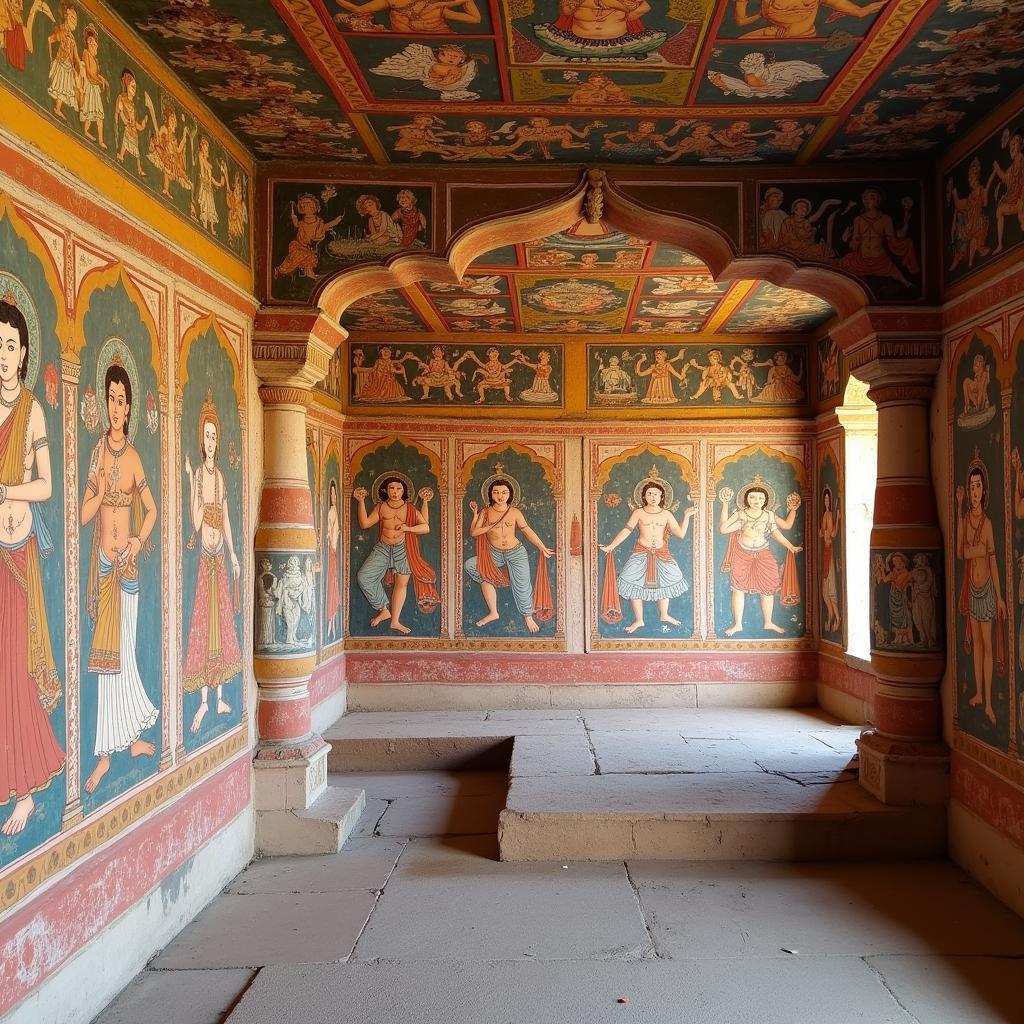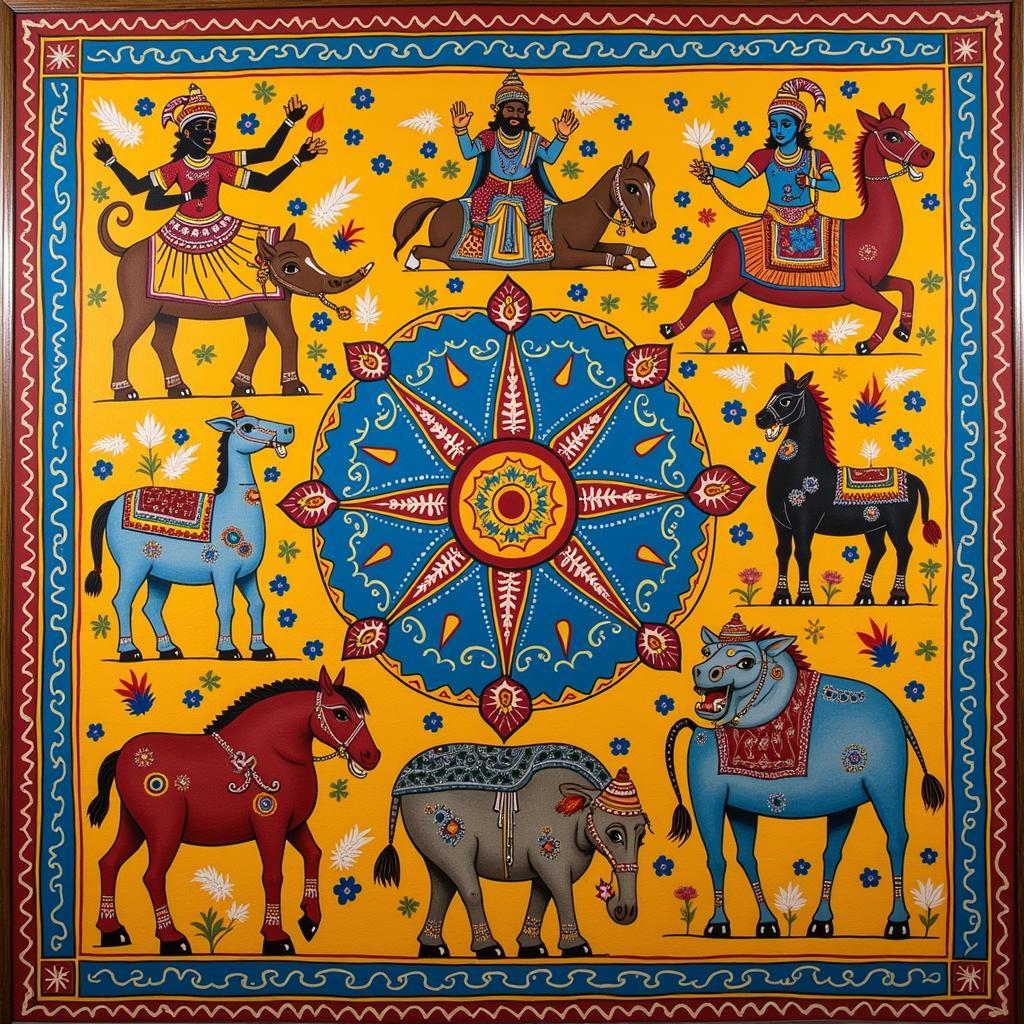Exploring the Vibrant World of Indian Wall Art Painting
Indian Wall Art Painting offers a captivating glimpse into a rich cultural heritage, transforming spaces with vibrant colors and intricate designs. From traditional Warli paintings to contemporary interpretations, these artistic expressions add a unique touch to any environment. This article will delve into the fascinating world of Indian wall art painting, exploring its history, techniques, and the diverse styles that make it so compelling. See how you can incorporate these stunning pieces into your own home décor and celebrate the beauty of Indian art.
Indian wall art paintings are more than just decorative elements; they are stories etched onto walls, narratives of mythology, nature, and everyday life. Whether you are an art enthusiast, an interior designer, or simply someone looking to add a touch of cultural richness to your home, exploring this art form is a journey of discovery. Let’s begin by unraveling the historical significance of these captivating paintings. We’ll also explore how india wall art can beautifully complement other forms of art.
A Journey Through Time: The History of Indian Wall Art Painting
The history of Indian wall art painting stretches back millennia, with evidence found in ancient cave paintings and murals adorning palaces and temples. From the Ajanta and Ellora Caves to the intricate frescoes of Rajasthan, these paintings showcase the evolution of artistic techniques and the enduring power of storytelling. The Warli tribe, for example, uses a basic vocabulary of geometric shapes to depict scenes of their daily lives, creating a unique and visually stunning narrative. Similarly, Madhubani paintings, originating in the Mithila region of Bihar, are known for their vibrant colors and depiction of Hindu deities and mythology.
Each region of India has its own distinctive style of wall painting, reflecting the local culture, traditions, and beliefs. Tanjore paintings, originating in Thanjavur, Tamil Nadu, are characterized by their rich gold leaf and embedded precious stones, while the Pattachitra style of Odisha uses intricate line work and bold colors to portray mythological scenes. These diverse traditions offer a captivating insight into the artistic heritage of India.
 Indian Wall Art Painting History: Ajanta Caves Murals
Indian Wall Art Painting History: Ajanta Caves Murals
Exploring Diverse Styles: From Traditional to Contemporary
Indian wall art painting encompasses a wide range of styles, from the traditional to the contemporary. Each style offers a unique aesthetic and narrative, appealing to diverse tastes and preferences. Warli paintings, with their minimalist aesthetic and depiction of rural life, bring a touch of earthy charm to any space. Madhubani paintings, with their vibrant colors and intricate details, create a sense of celebration and festivity.
Contemporary Indian wall art often draws inspiration from traditional styles while incorporating modern elements and techniques. Artists experiment with new mediums and interpretations, pushing the boundaries of this ancient art form. This fusion of tradition and modernity results in captivating pieces that resonate with contemporary audiences while honoring the rich heritage of Indian art. You might find contemporary pieces that blend Warli motifs with abstract elements or Madhubani designs reimagined in a minimalist palette.
Incorporating Indian Wall Art Painting into Your Home
How can you bring the beauty of Indian wall art painting into your own home? Whether you choose a traditional Warli painting, a vibrant Madhubani artwork, or a contemporary interpretation, these pieces can transform your living space. Consider the existing décor and color palette of your room when selecting a piece. A large-scale Warli painting can be a focal point in a minimalist living room, while a series of smaller Madhubani paintings can add a pop of color to a hallway or bedroom. Remember that ganesha wall art adds a spiritual and artistic touch to any space.
Frequently Asked Questions about Indian Wall Art Painting
-
What are some common themes in Indian wall art painting? Common themes include mythology, nature, daily life, festivals, and royal courts.
-
What materials are used in Indian wall art painting? Traditional materials include natural pigments, clay, cow dung, rice paste, and vegetable dyes. Modern artists may also use acrylic paints and other mediums.
-
How do I care for my Indian wall art painting? Avoid direct sunlight and moisture. Dust regularly with a soft cloth. For more serious cleaning, consult a professional art restorer.
-
Where can I buy authentic Indian wall art paintings? You can find authentic pieces in art galleries, craft shops, and online marketplaces. Be sure to do your research and purchase from reputable sellers.
-
Can I commission a custom Indian wall art painting? Yes, many artists accept commissions for custom pieces. This is a great way to get a unique artwork tailored to your specific preferences and space.
-
What is the significance of colors in Indian wall art painting? Colors often hold symbolic meaning. For example, red may represent power and passion, while green symbolizes fertility and prosperity.
Conclusion: Embrace the Beauty of Indian Wall Art Painting
Indian wall art painting offers a unique way to infuse your home with color, culture, and history. From the ancient traditions of Warli and Madhubani to contemporary interpretations, these artworks offer a captivating glimpse into the rich artistic heritage of India. Whether you’re looking to create a statement piece or add a subtle touch of cultural flair, exploring the world of Indian wall art painting is a journey of artistic discovery. Consider adding a piece of texas wildflower art to complement your Indian wall art and create a diverse and beautiful art collection.
 Indian Wall Art Painting: Contemporary Style
Indian Wall Art Painting: Contemporary Style
What other questions do you have about incorporating Indian wall art painting into your décor? Explore more about sand art indian and lawrence art in the park for further artistic inspiration.
Need help finding the perfect piece? Contact us! Phone: 02462573573, Email: [email protected] or visit us at Savico Megamall, 7-9 Đ. Nguyễn Văn Linh, Gia Thụy, Long Biên, Hà Nội 10000, Việt Nam. We have a 24/7 customer support team.
